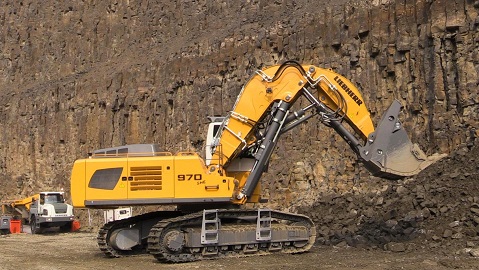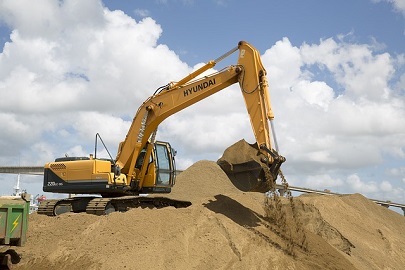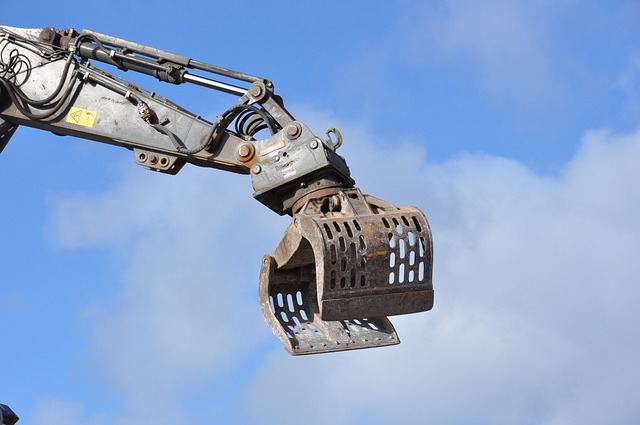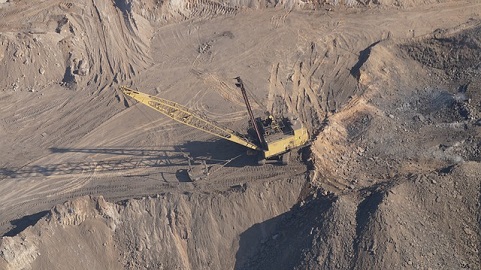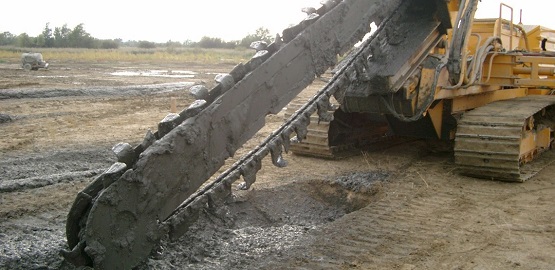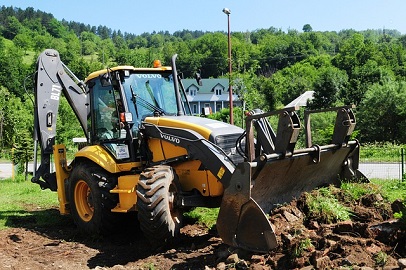Excavating plant
Contents |
[edit] Introduction
Excavators are a common item of plant that can be used on construction sites to excavate and load most types of soil. Before beginning excavation works, there must be a plan for the areas that require excavating as well as where the excess material will be stored.
Very broadly, types of excavating plant can be categorised as:
- Hydraulic (face shovel or backacter).
- Dragline.
- Trenching machine (or skimmer).
- Multi-purpose.
Generally, the choice of excavating plant will depend on:
- The quantity of material to be excavated.
- The type and condition of the soil.
- The weather conditions.
- The speed of excavation required.
- The depth of the excavation.
- The material disposal method (side cast or cart away).
[edit] Hydraulic excavators
These are tracked machines with a slewing capacity of 360-degrees, capable of adapting to a wide range of different requirements. The typical bucket size is 1 m3.
[edit] Face shovels
Face shovels are characterised by a boom and bucket arm that extends and swings upwards from the front. It can be used to excavate any kind of soil, including rock that has been loosened by blasting. It is usual for an additional haulage vehicle to be required for spoil removal, as well as a low loader transport lorry for travelling between sites. Face shovels are limited to an excavation depth of 300-400 mm below their own track or wheel level.
[edit] Backacter or back actor
A backacter (or back actor) is fitted with a boom and bucket arm or a dipper arm that excavates downwards. They are most suited to trench, foundation and basement excavations. The depth of the dig can be up to 6-7 m, although arm extensions can be added if further depths are required. In excavation operations where the bucket width is equal to the trench width, increased accuracy and high productivity rates can be achieved.
For more information, see back actor.
[edit] Hydraulic clamshell
Hydraulic clamshells are used in situations that are too difficult for a backacter, such as dredging and caisson sinking. They are suited to excavating very loose soils, as the bucket grabs and lifts rather than scoops and lifts.
[edit] Dragline
Draglines are fitted with a basic crane jib which uses a rope or chain to control a drag bucket which is swung out to the excavation position and hauled or dragged back towards the power unit. It is best suited to bulk excavation in loose or waterlogged soils below its own track level.
[edit] Trenching machine
Also known as a skimmer, a trenching machine is used for excavating long trenches, such as those necessary for pipelines. They will normally dig trenches 0.25-1.5 m wide and up to depths of 3 m, where a high degree of accuracy is required. The machine moves forwards when excavating with buckets either mounted on a wheel at the front, or on a chain which is carried by a jib.
[edit] Multi-purpose excavator
These are the most common ‘JCB digger’ machines, intended for small to medium-sized excavation works. They are fitted with loading/excavating front buckets with widths up to 2 m and a rear backacter bucket that has a 180-degree arc of operation. Both are hydraulically controlled by the operator/driver. Use of the backacter bucket requires that the machine is raised off its axles using rear-mounted hydraulic outriggers or jacks.
The machine is flexible in that it can be fitted, usually on the backacter dipper arm, with a variety of bucket widths and attachments such as bulldozer blades, scarifiers, grab buckets and post-hole auger borers.
[edit] Related articles on Designing Buildings Wiki
- Amphibious excavators.
- Building foundations.
- Compressed air plant.
- Concreting plant.
- Construction plant.
- Construction skip.
- Dredging.
- Earth-moving plant.
- Groundworks.
- Pumps and dewatering equipment.
- Ripping.
- Temporary works.
- Trenching equipment.
- Tunnelling.
[edit] External references
- ‘Introduction to Civil Engineering Construction’ (3rd ed.), HOLMES, R., The College of Estate Management, (1995)
- ‘Building Construction Handbook’ (6th ed.), CHUDLEY, R., GREENO, R., Butterworth-Heinemann, (2007)
Featured articles and news
How big is the problem and what can we do to mitigate the effects?
Overheating guidance and tools for building designers
A number of cool guides to help with the heat.
The UK's Modern Industrial Strategy: A 10 year plan
Previous consultation criticism, current key elements and general support with some persisting reservations.
Building Safety Regulator reforms
New roles, new staff and a new fast track service pave the way for a single construction regulator.
Architectural Technologist CPDs and Communications
CIAT CPD… and how you can do it!
Cooling centres and cool spaces
Managing extreme heat in cities by directing the public to places for heat stress relief and water sources.
Winter gardens: A brief history and warm variations
Extending the season with glass in different forms and terms.
Restoring Great Yarmouth's Winter Gardens
Transforming one of the least sustainable constructions imaginable.
Construction Skills Mission Board launch sector drive
Newly formed government and industry collaboration set strategy for recruiting an additional 100,000 construction workers a year.
New Architects Code comes into effect in September 2025
ARB Architects Code of Conduct and Practice available with ongoing consultation regarding guidance.
Welsh Skills Body (Medr) launches ambitious plan
The new skills body brings together funding and regulation of tertiary education and research for the devolved nation.
Paul Gandy FCIOB announced as next CIOB President
Former Tilbury Douglas CEO takes helm.
UK Infrastructure: A 10 Year Strategy. In brief with reactions
With the National Infrastructure and Service Transformation Authority (NISTA).
Ebenezer Howard: inventor of the garden city. Book review.
The Grenfell Tower fire, eight years on
A time to pause and reflect as Dubai tower block fire reported just before anniversary.
Airtightness Topic Guide BSRIA TG 27/2025
Explaining the basics of airtightness, what it is, why it's important, when it's required and how it's carried out.
Construction contract awards hit lowest point of 2025
Plummeting for second consecutive month, intensifying concerns for housing and infrastructure goals.
Understanding Mental Health in the Built Environment 2025
Examining the state of mental health in construction, shedding light on levels of stress, anxiety and depression.






